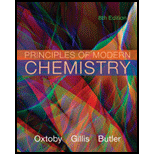
Concept explainers
(a)
Interpretation:
The element with higher first ionization energy should be predicted from BiandXe.
Concept Introduction:
The amount of energy required to remove an electron from an isolated gaseous atom to form an ion is termed as ionization energy.
(b)
Interpretation:
The element with higher first ionization energy should be predicted from Se and Te.
Concept Introduction:
The amount of energy required to remove an electron from an isolated gaseous atom to form an ion is termed as ionization energy.
(c)
Interpretation:
The element with higher first ionization energy should be predicted from Rb andY.
Concept Introduction:
The amount of energy required to remove an electron from an isolated gaseous atom to form an ion is termed as ionization energy.
(d)
Interpretation:
The element with higher first ionization energy should be predicted from KandNe.
Concept Introduction:
The amount of energy required to remove an electron from an isolated gaseous atom to form an ion is termed as ionization energy.
Want to see the full answer?
Check out a sample textbook solution
Chapter 3 Solutions
Bundle: Principles of Modern Chemistry, 8th + OWLv2, 1 term (6 months) Printed Access Card
- In the kinetic theory of gases, explain the concept of the velocity distribution function of particles.arrow_forwardHi!! Please provide a solution that is handwritten. this is an inorganic chemistry question please answer accordindly!! its just one question with parts JUST ONE QUESTION with its parts spread out till part (g), please answer EACH part till the end and dont just provide wordy explanations wherever asked for structures, please DRAW DRAW them on a paper and post clearly!! answer the full question with all calculations step by step EACH PART CLEARLY please thanks!! im reposting this please solve all parts and drawit not just word explanations!!arrow_forwardHi!! Please provide a solution that is handwritten. this is an inorganic chemistry question please answer accordindly!! its just one question with parts JUST ONE QUESTION, please answer EACH part PART A AND PART B!!!!! till the end and dont just provide wordy explanations wherever asked for structures, please DRAW DRAW them on a paper and post clearly!! answer the full question with all details EACH PART CLEARLY please thanks!! im reposting this please solve all parts and drawit not just word explanations!!arrow_forward
- Hi!! Please provide a solution that is handwritten. this is an inorganic chemistry question please answer accordindly!! its just one question with parts JUST ONE QUESTION, please answer EACH part till the end and dont just provide wordy explanations wherever asked for structures, please DRAW DRAW them on a paper and post clearly!! answer the full question with all details EACH PART CLEARLY please thanks!! im reposting this please solve all parts and drawit not just word explanations!!arrow_forward8b. Explain, using key intermediates, why the above two products are formed instead of the 1,2-and 1,4- products shown in the reaction below. CIarrow_forward(5pts) Provide the complete arrow pushing mechanism for the chemical transformation depicted below Use proper curved arrow notation that explicitly illustrates all bonds being broken, and all bonds formed in the transformation. Also, be sure to include all lone pairs and formal charges on all atoms involved in the flow of electrons. CH3O H I I CH3O-H H I ① Harrow_forward
- 1. For each of the following, predict the products of the reaction by writing a balance net ionic equation for each. If no reaction is expected, then write NO REACTION. (a) AgNO3 (aq) is mixed with Na2CO3 (aq). (b) An aqueous solution of ammonium sulfate is added to an aqueous solution of calcium chloride. (c) RbI (aq) is added to Pb(NO3)2 (aq). (d) NaCl (s) is added to AgNO3 (aq).arrow_forward4. Determine the amount in grams of AgCl (s) formed when 2.580 g AgNO3(s) is added to 45.00 mL of a 0.1250 M CrCl3 (aq) (The other product is aqueous chromium (III) nitrate) 5. Determine the amount (in grams) of Cobalt (II) phosphate formed when an aqueous solution of 30.0 ml of 0.450 M Sodium Phosphate is mixed with 20.0 mL of 0.500 M aqueous solution of cobalt (II) nitrate. (The other product is aqueous sodium nitrate)arrow_forward7. Consider the following reaction that describes the dissolution of copper metal in nitric acid: Cu (s) + 4 HNO3 (aq) → Cu(NO3)2 (aq) + 2 H₂O (1) + 2 NO2 (g) How many mL of 3.50 M HNO3 (aq) are required to dissolve 20.00 g Cu?arrow_forward
 Principles of Modern ChemistryChemistryISBN:9781305079113Author:David W. Oxtoby, H. Pat Gillis, Laurie J. ButlerPublisher:Cengage Learning
Principles of Modern ChemistryChemistryISBN:9781305079113Author:David W. Oxtoby, H. Pat Gillis, Laurie J. ButlerPublisher:Cengage Learning
